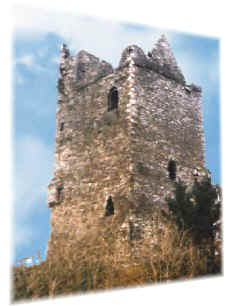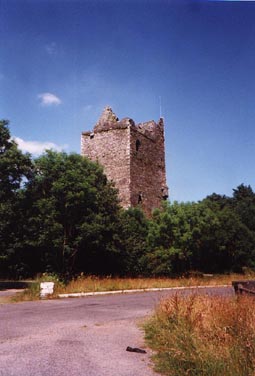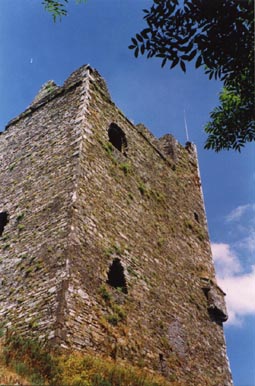Name: Ballinacarriga
Location: Cork
Country: Ireland
Review
this castle

Beal na Carraige -
“The mouth or Passage of the Rock” Ballinacarriga castle lies just off the
main road from Ballineen to Dunmanway, about halfway between these towns.
From there a side road clearly signposted goes for about a mile and a half over
Manch Bridge and the Bandon River
to the castle. To the south there is a lake and from it a stream runs
under a small bridge and the walls of the castle to join the Bandon River to the
North. It provided a supply of water to the castle in the days of its
glory.

The castle is
a four story tower, built on a rocky eminence with a good view in all
directions, and overlooks Ballinacarriga lough (lake). It is unique
for the number of important stone carvings it contains, mainly on what was the
third floor, which is easily accessible by a circular stairway built into the
thickness of the wall. These carvings are mostly of a religious nature.
In one window arch, on the top floor, the Crucifixion is shown, Christ on the
cross, between two thieves, with the instruments of the passion nearby – a
crown of thorns, a hammer, and a heart pierced with two swords. In the
soffit on the north window are the initials “R.M. C.C.” and the date 1585.
These are believed to be the initials of Randal Murlihy (Hurley) and his wife
Catherine Cullinane, and the date of the erection of the building – although
its is generally accepted that the greater part of the castle is older and may
have been in the possession of the MacCarthys before the Hurleys took over.
Formerly, the Hurleys occupied lands about a mile to the south, in the townland
of Gloun, where some scant remains of buildings are to be seen. On the
opposite window are intricate carvings around a chessboard design, and also the
figure of a woman with five
roses, which has been stated to represent Catherine Cullinane and her five
children, but is more generally believed locally to be of the Blessed Virgin.

All these carvings would tend to support a local tradition that the top floor
was used as a chapel as well as being the main living room of the castle.
It
is believed that Mass was still being said here until the nearby chapel was
built in 1815 by Father James Doheny, although the castle itself would long have
been uninhabited by then. The presence of a “Sheila na Gig” above and to the
right of the main door of the castle would appear to substantiate this, as these
unusual female figure are often for some unknown reason found on the outside
walls of medieval churches. Outside to the southeast is the remnant of one of
the four defense towers, which guarded the main tower of the castle itself.
The other three have disappeared.
The basement of the castle would have had a wooden ceiling – the stone corbels
to keep it in place are still to be seen, as is the impressive high stone arch
of the second floor. On the second floor there is a mural gallery (that is
built into the thickness of the wall) leading to the garderobe, or lavatory,
which is on the north side over a chute. For some reason this is known as
“Moll the Phooka’s Hole”. Phookas being associated with wrecked
castles. They are usually believed to take the form of a black horse, or
sometimes a large black dog. The third floor contains the carvings already
mentioned, and also a fine fireplace. The roof of course is missing, as
are the parapets with their battlements. The castle is reported to have been
occupied by a garrison of Cromwell’s men for a time and when they were leaving
they would, as was their usual practice,
have removed the overhanging parapets with their machicolations, thus depriving
the castle of its main defense against further attack. However there
remains a machicolous of a rather unusual type on each of the southeast and
northwest corners of the building, complete with their machicolations (which are
the holes, downwards, through which the defenders could fire arrows or guns, or
pour molten lead). The castle provides an excellent opportunity for visitors to
get a good idea of what a medieval castle was like to live in.